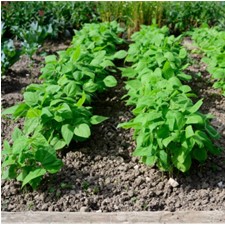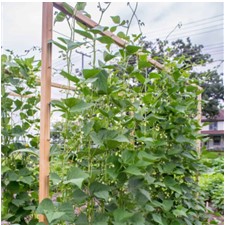Plant Green Beans for a Fall Harvest
Stephen Brueggerhoff, CEA – Horticulture; Texas A&M AgriLife Extension Service
8/16/2021
Preparing green beans is just one part of my childhood gardening experience, a seasonal ritual at my grandmother’s house whenever we would visit in mid-spring and in the fall. Harvest appeared to be plentiful, preparation was necessary, and this was one tried and true activity that mamaw could use to keep me, my brother and my sisters corralled and contributing to the family meal. We are fast approaching our fall gardening season, and this is the perfect time to plant snap beans and involve your children in planting, growing, and harvesting for future meals.
 Snap beans, also called green beans (Phaseolus vulgaris) have two basic growth forms that we use in the garden. Like the name suggests, bush beans are more compact, foliage growing in a mound shape at about 2-feet tall and not requiring a structure for support. Pole beans are climbing vines that may sprawl up to 15-feet long and require a trellis for support. You will have more success direct sowing seed in a prepared well-draining and nutrient rich bed. If you have ample room to cultivate, AgriLife Vegetable Specialist Dr. Joe Masabni recommends up to one-half pound of seed for each 100 feet of row. Choose seed lots that have been pre-treated with a fungicide to reduce fungal infection on newly emerging leaves and roots.
Snap beans, also called green beans (Phaseolus vulgaris) have two basic growth forms that we use in the garden. Like the name suggests, bush beans are more compact, foliage growing in a mound shape at about 2-feet tall and not requiring a structure for support. Pole beans are climbing vines that may sprawl up to 15-feet long and require a trellis for support. You will have more success direct sowing seed in a prepared well-draining and nutrient rich bed. If you have ample room to cultivate, AgriLife Vegetable Specialist Dr. Joe Masabni recommends up to one-half pound of seed for each 100 feet of row. Choose seed lots that have been pre-treated with a fungicide to reduce fungal infection on newly emerging leaves and roots. Plant seed of both forms about 1-inch deep. I always plant additional seeds of bush beans in the garden and then thin as needed to ensure adequate production, and final spacing should be 4-inches apart in the row. For pole beans I create small mounds spaced at 3-feet apart, then plant about 4 beans around the mound. You can create a trellis along the length of the row or use a single-stake trellis for support. Make sure to keep the soil moist until germination, then reduce watering to twice a week or as needed as the plants mature.
Plant seed of both forms about 1-inch deep. I always plant additional seeds of bush beans in the garden and then thin as needed to ensure adequate production, and final spacing should be 4-inches apart in the row. For pole beans I create small mounds spaced at 3-feet apart, then plant about 4 beans around the mound. You can create a trellis along the length of the row or use a single-stake trellis for support. Make sure to keep the soil moist until germination, then reduce watering to twice a week or as needed as the plants mature.
Fertilizer application is dependent on soil nutrient availability and committing a soil test for your garden will provide you with a foundation of useful information that will help guide best gardening practices. A general application of 5-10-15 fertilizer per 100-feet of row mixed into the top 3-inches of soil prior to planting will suffice. Dr. Masabni recommends applying a half cup of fertilizer for every 10-feet of row after flowering and bean set. Always water after fertilizing. Beans produce fibrous roots growing shallow in the soil profile, and care should be taken when using a garden hoe while grubbing out weeds. Depending on the variety, beans should be ready for harvest within 45 to 60 days after germination. Keep an eye on their growth and harvest while still immature, or about the size of a pencil. They become tough and stringy if left on the plant for too long. There are several varieties that will perform well in our area and try out bush form Early Contender at 55 days, Derby at 57 days, Provider at 50 days, or Blue Lake at 60 days. Pole beans include Purple King at 75 days, Rattlesnake at 73 days, or Northeaster at 56 days.
Growing, harvesting, and preparing vegetables like green beans is a great way to involve our children and create future meals and lasting memories. Additional vegetable planting at this time can include cucumbers and summer squash, and tomatoes by transplant. Look forward to greens, bok choy, beets, carrots and more that can be planted by seed in September. You can find a Brazoria County planting guide and recommended varieties from the horticulture section of our website: https://brazoria.agrilife.org. I also encourage you to share your gardening stories and let me know what you are interested in reading by browsing online to my Facebook page: www.facebook.com/horticulturiststephenb. Happy fall gardening, and I’ll see you in the garden.
